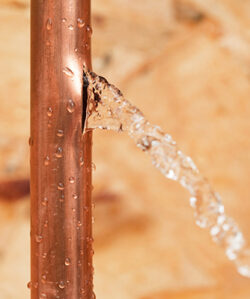Copper Vs. Galvanized Pipes: What You Need to Know
When determining how to install plumbing in homes, builders have a variety of plumbing pipes to choose from. Copper and galvanized pipes are two of the most common types that are utilized in plumbing. They may be similar in certain aspects, but they have distinct differences. We’ll explore these below.
Galvanized Pipe
Galvanized pipes are made by dipping steel pipes in a zinc coating that provides protection. The zinc covering offers a layer of protection from rust and corrosion. Plumbing in houses constructed before 1960 frequently made use of galvanized pipes. Before galvanized pipes were created, lead pipes were the standard for homes and were used for water lines. Unfortunately, lead, which is harmful when ingested, mixes with drinking water and lowers its quality. Therefore, plumbing didn’t suit these pipes. As an alternative to offset for lead pipes, galvanized pipes were created.
Even though modern residential plumbing systems no longer use galvanized pipes, they are still present in many older residences. Galvanized pipe lifespan ranges from 30 to 40 years. Unfortunately, these pipes tend to rust inside, and the water flowing from them tends to erode and change color. Although these pipes are robust, eventually, they become rusty. In addition, old galvanized pipes can break in cold climates when ice-cold water expands and pushes up against the walls of the rusted metal pipes.
Although different pipeline materials are now primarily utilized for this purpose, galvanized pipes were once employed to carry natural gas. Unfortunately, natural gas erodes the zinc coating on galvanized pipes, which results in zinc flakes clogging the pipe, making them unsuitable for conveying natural gas.
Galvanized pipes are often not appropriate for plumbing projects because they cannot tolerate the hardness of water. Calcium, magnesium, iron, and lime are just a few minerals that may make water hard. Galvanized coating gradually disappears due to the steady flow of hard water. Additionally, the zinc coating on the pipe corrodes when hard water interacts with it.
Advantages of galvanized pipe:
- Durable
- Great for sewage plumbing
- The coating prevents rust and corrosion
- Coated with Zinc
- Fire resistant
- Works under freezing temperatures
Disadvantages of galvanized pipe:
- Ability to rust in smaller sizes
- Coating can chip
- Costly
Copper Pipe

Copper pipes are made in four grades for use in home plumbing installations. ‘Type K’ copper pipe is the heaviest and the most used for home plumbing. For water lines in the home, a narrower ‘Type’ L copper pipe is used. The ‘Type M’ copper pipe is typically used for light plumbing installations since it is even lighter than the Type L. The last type of copper pipe is called a ‘DMW’; it is skinny and is mainly used for drainage and waste.
Copper pipes can withstand heat and are corrosion-resistant. Due to the absence of lead in copper pipes, they are safer than galvanized ones. Because of their lower diameter, you can also use copper pipes in confined spaces. Moreover, copper pipes prevent bacterial development, so it’s safer to use for drinking water pipes. Additionally, copper doesn’t break down in the water. All these reasons can be why copper pipe has been the standard since the 1960s in residential plumbing installations.
Even though copper pipes are fantastic, there are some drawbacks. Copper pipes are also liable to break when the water temperature reaches 180 degrees. Copper pipes may also develop condensation. The water flow stops when moisture within these pipes freezes. Unfortunately, the cost of copper pipes is a significant disadvantage. Galvanized and other types of plumbing pipes are less expensive than copper pipes. In addition, installations using copper pipes are more expensive.
Also, copper pipes can leave a metallic taste in water. Copper pipes also have the drawback of forming more condensation when the water temperature reaches 180 degrees, and if that occurs, the water can freeze and stop the pipe’s water flow.
Advantages of copper pipe:
- Don’t contain lead
- Resistant to fires
- Available in small sizes
- Biostatic
- Resistant to corrosion
- Does not contaminate the water
- Lightweight
- Environmentally friendly
Disadvantages of copper pipe:
- Susceptible to freezing temperatures
- Leaves a metallic taste behind
- Not good in freezing temperatures
- More expensive than other pipes
- Condensation forms quick
- Not good with water acidity
Let Us Do the Work
Mullen Plumbing, Heating and Cooling has been offering the highest quality plumbing repair to South Charleston, WV, residents and business owners for more than 70 years. Our plumbing services aim to address all of your plumbing difficulties, including those caused by corroded pipes, broken water heaters, and clogged drains, which may be a great pain for a homeowner. Our family-owned business provides quick, dependable plumbing repairs to get your house back in working order. We’re also proud to handle your HVAC repair, installation, and maintenance services. Call the Mullen Plumbing, Heating and Cooling team for all your household heating, cooling, and plumbing needs in South Charleston.
